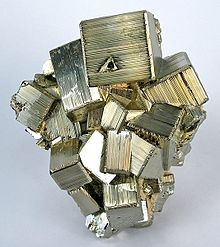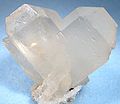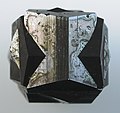Crystal twin

Crystal twin is a term from crystallography and describes at least two or more crystals that are naturally grown together and have the same chemical composition and crystal structure .
Due to the formation of twins or multiple crystals, crystal twins or multiples have additional symmetry elements that do not occur in the space group of non-twinned single crystals and thus lead to an increase in symmetry. The additional symmetry elements can be a mirror plane (twin plane ) or an axis of rotation ( twin axis or triple axis ). In the case of acentric crystals, an inversion center can also be created by point reflection. In its position to the two crystal individuals, the additional symmetry element obeys the law of rationality .
If more than two individuals are involved in the formation of twins, one also speaks of triplets, quadruplets or multi-linges, and repetitive twinning results in repetitive multi-twins or polysynthetic twins.
While non-twinned crystals always form convex polyhedra, crystal twins, with the exception of the inversion twins, can often be easily recognized by the re-entrant angles.
Twinning and shapes
According to the type of adhesion
According to the type of adhesion, three possible twin formations can be distinguished:
- In the case of contact or touch twins , the two individuals are mirror images of one another at the level of adhesion. Typical crystal forms such as the well-known "swallowtail" in plaster of paris , the heart-shaped quartz twin according to the "Japanese law" or the knee- shaped twins of rutile are often created .
- In the case of penetration twins , the axes of the individuals cross each other, with more or less irregular interfaces appearing on the bodies depending on the penetration angle. Penetration twins are known primarily from fluorite , galena , pyrite , sphalerite and staurolite .
Centrosymmetric penetration creates special shapes such as B. the staurolite cross or the "iron cross" in pyrite. In acentric interpenetrating twins, the centers of the two individuals are shifted from one another. Well-known representatives are the "Carlsbad twins" of the Orthoclase . - Rotational twins or cyclic twins arise when three or more individuals grow together and are arranged around a common axis of rotation. Known representatives of this Zwillingsart include Chrysoberyll - and aragonite -Drillinge, Adular -Vierlinge and annular Rutilmehrlinge that are composed of eight individuals (Rutilachtlinge).
Crystal twins, which simulate a higher symmetry than corresponds to the crystal structure of the individual crystal, are also referred to as complementary twins or mimetic twins. Representatives of this type can be found predominantly among the contact twins and rotation multiples.
According to the type of origin
Different crystal twins can also be distinguished depending on the type of formation conditions:
- In the case of growth twins, the type of twin formation is already determined by the crystallization nucleus .
- Sliding twins or pressure twins arise through mechanical deformation, among other things, in that the pressure is exerted in the direction of a sliding plane of the atomic lattice. In this way, z. B. from a single lamella free calcite - rhombohedron a dovetail twin generate by carefully with a cutting presses on the blunt edge of the rhombohedron.
- Conversion twins are formed in polymorphic substances that pass through different crystal systems during crystallization and subsequent cooling . During the conversion, individual slip planes can fold over at an interface and lamellar contact twins are created, and polysynthetic twins if the grid is turned over repeatedly.
Analysis and classification
The concept of point groups is very helpful for the analysis of crystal twins . When describing the respective twin laws, the symmetry elements are expressed by Miller indices .
According to the rules of François Ernest Mallard, the twin symmetry simulates a higher symmetry than corresponds to the actual crystal structure, which is why one speaks of the twin lattice as opposed to the actual crystal lattice. The actual crystal lattice can be found by omitting symmetry elements of the twin lattice. The crystal lattice is therefore a subgroup of the point group of the twin lattice.
If the twin lattice and crystal lattice belong to the same Lau group , one speaks of a merohedral crystal twin . In all other cases it is a question of non-merohedral crystal twins. In the triclinic , monoclinic and orthorhombic crystal system , merohedral crystal twins are always inversion twins.
Crystal twins are usually classified according to the rules introduced by Georges Friedel in 1926, which assign the twins to four different groups based on the two criteria Meroedrie and Schiefe:
- Meroedrie - complete and exact overlap of the lattices of the twin crystals
- Pseudomeroedry - complete but approximate overlap (Mallard's law)
- Reticular meroedry - partially but with exact overlap
- Reticular pseudomeroedry - partial and approximate overlap
Twin laws
Twin laws, i.e. the regularities according to which two individuals can be oriented towards each other, are very diverse and are usually identified by special names. The twin laws are mainly named after the type of mineral for which this twin law is characteristic or after the place where a corresponding crystal twin was first found.
- Albite and pericline law, see Albite
- Twin laws in orthoclase : Baveno law, Karlsbader law, Manebach law
- Pyrite Law
- Twin laws for quartz : Belodwa-Beacon-Twin, Brazilian Twin, Cornish-Twin, Dauphinée-Twin (also Alpine or Swiss Law), Esterel-Twin, Japanese-Twin, Liebisch-Twin, Pierre-Levee-Twin, Sardinia-Twin, Wheal -Coats twin
- Rutile law
- Spinel law
literature
- Hans Jürgen Rösler : Textbook of Mineralogy . 4th revised and expanded edition. German publishing house for basic industry (VEB), Leipzig 1987, ISBN 3-342-00288-3 , p. 86-87 .
- Friedrich Klockmann : Klockmann's textbook of mineralogy . Ed .: Paul Ramdohr , Hugo Strunz . 16th edition. Enke, Stuttgart 1978, ISBN 3-432-82986-8 , pp. 72–75 (first edition: 1891).
- Rudolf Graubner: Lexicon of geology, minerals and rocks . Emil Vollmer Verlag GmbH, Munich 1980, ISBN 3-87876-327-1 , p. 422-426 .
- Günter Gottstein: Physical Basics of Material Science . Springer, 2001, ISBN 978-3-540-41961-7 , 6.3.2 Mechanical twin formation, p. 207 ( limited preview in Google Book search).
- William F. Hosford: The Mechanics of Crystals and Textured Polycrystals . Oxford University Press, New York, Oxford 1993, ISBN 0-19-507744-X (Oxford engineering science series).
- Jean-Claude Boulliard: Le cristal et ses doubles . CNRS Editions, Paris 2010, ISBN 978-2-271-07049-4 .
Web links
- Mineral Atlas: Gemini
- University of Stuttgart: Modulated and twinned structures (PDF 6.7 MB)
- IUCr Online Dictionary (English)







